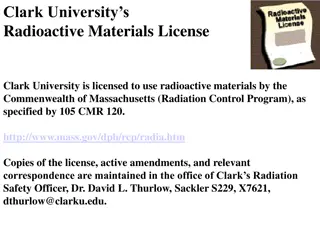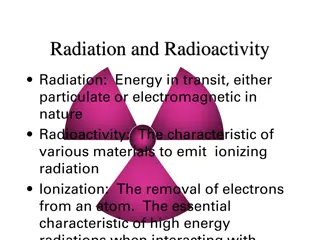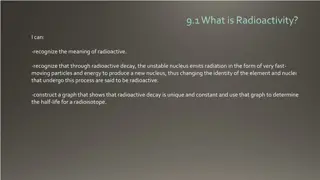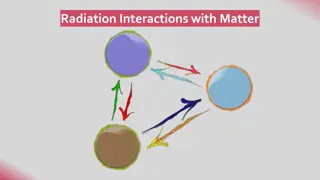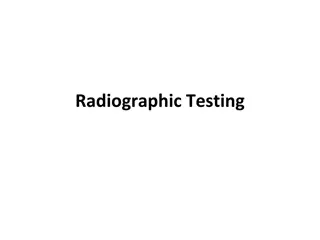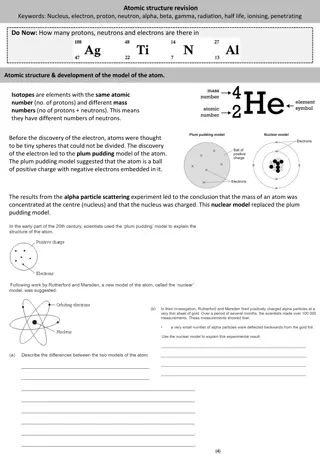Understanding Alpha, Beta, and Gamma Radiation: a Comparative Analysis
Explore the key differences between alpha, beta, and gamma radiation, their structures, penetration powers, absorption materials, ionizing abilities, and dangers. Learn about isotopes, radioactive decay, and the unique characteristics of each type of radiation. Dive into creating fact sheets and understand the risks associated with these radiation types.
Download Presentation

Please find below an Image/Link to download the presentation.
The content on the website is provided AS IS for your information and personal use only. It may not be sold, licensed, or shared on other websites without obtaining consent from the author. Download presentation by click this link. If you encounter any issues during the download, it is possible that the publisher has removed the file from their server.
E N D
Presentation Transcript
LO: To compare alpha, beta and gamma radiation WEEK 2 Expected progress: 1) Will have researched and stated key facts about alpha, beta and gamma radiation 2) Will have compared the dangers of alpha, beta and gamma radiation. Better than expected progress: 1) Will have applied knowledge to answer questions on SENECA. CONNECT: WATCH THE CLIP BELOW TO INTRODUCE YOU TO ALPHA, BETA AND GAMMA RADIOACTIEV PARTICLES https://www.bbc.co.uk/bitesize/clips/z88fgk7
WEEK 2: TASK 1 Read through this slide to recap the structure of an atom Explain what an isotope is. Explain what happens in the process of radioactive decay. Atoms have a nucleus which contains protons that have a positive charge and neutrons that have a neutral charge. Electrons which have a negative charge orbit the nucleus in electron shells. All atoms have the same number of protons and electrons but some atoms of the same element have different amount of neutrons and are called isotopes. Some isotopes release radiation from their nuclei in a process called radioactive decay and are called radioactive isotopes.
WEEK 2: TASK 2 Use the next few slides to produce fact sheets (on paper or power point/word/publisher) for alpha, beta and gamma radiation. For each radioactive particle include the following information: A diagram A symbol A description of the structure Penetration power (what materials can it pass through) What materials absorb it (or stop it passing through) How ionising is it How fast is it/how far can it travel in the air Make a poster/leaflet warning people of the dangers of alpha, beta and gamma radiation. Include: Which is the most dangerous outside the body Which is the most dangerous inside the body What damage can each cause
Type of radiation Diagram of the radiation type Description of the radiation type Penetration Power of the radiation type What is it absorbed by? What is the ionising power? Alpha It has 2 protons and 2 neutrons which is the same as a helium nucleus It is the least penetrating and it can only go through air a few centimetres. It moves slowly. It can be absorbed by sheet of paper It is the most ionising Beta It is an electron which is released from a nucleus after a neutron splits It can penetrate air and paper and travels quickly It is absorbed by thin aluminium It is strongly ionising Gamma It can penetrate air paper and thin metals and it travels at the speed of light It is absorbed by thick lead or concrete It is the least ionising. It has no mass or charge and it is part of the EM spectrum
Alpha, beta and gamma radiation Alpha radiation is the safest outside the body because it cannot pass through the skin. However, inside the body it is absorbed by cells so is very dangerous. Alpha radiation is used in smoke alarms and in the treatment of cancer cells. Beta and gamma radiation are more dangerous outside the body because they can pass through the skin but inside the body they are less dangerous because they passes through the cells and aren t absorbed. Beta is used to test the thickness of paper and foil and is used as medical tracers. Gamma radiation is used to sterilise medical equipment and also to kill cancer cells.
The dangers of alpha, beta and gamma radiation. Alpha radiation Beta radiation If alpha enters an organ, it can cause damage to the tissues of that organ. It can cause kidney damage. When beta particles enter the cells they alter the cell function. Alpha radiation can also damage the DNA of cells making the cells divide out of control which causes tumours, for example if alpha is inhaled then it can cause lung cancer. When they penetrate deeper into tissues like the tissues that form skin they alter the DNA of the cell and cause the cells to divide too quickly which causes cancers such as bone cancer. Gamma radiation is not as dangerous to cells and tissues inside the body as gamma radiation is not as easily absorbed by cells as alpha and beta radiation. Gamma radiation damages skin cells and tissues by altering the DNA or altering the cell function.







